Last Updated on December 29, 2021 at 5:29 pm
Let us discuss the answer to a question we received recently: “dear sir, can you please compare MF SIP vs lump sum returns and tell us which is a better way to invest in mutual funds?”. This question has been asked and analyzed for decades! Unfortunately, very few point this simple fact.
If you ask the wrong question, you will never find the right answer! Unless you stop and realise the problem. The problem is, no one ever is going to make just one (lump sum) investment!
Sure, I can easily compare SIP vs lump sum investment returns over 5 or 10 years in a few minutes. However, even if we do not start a SIP (or equivalently invest manually each month), we will not make one investment and stop for the next 5 or 10 years!
Academics have been compared these two modes for decades to get degrees. They would compare a 12,000 USD lump sum investment with a 100 USD monthly investment over 120 months (dollar-cost averaging). Sure it makes numerical sense, but no practical sense. A guy who can invest 12, 000 USD in one stroke would invest a lot more over the next 120 months, and very few people continue investing each month diligently over 120 months.
Join 32,000+ readers and get free money management solutions delivered to your inbox! Subscribe to get posts via email! (Link takes you to our email sign-up form)
🔥Want to create a complete financial plan? Learn goal-based investing? Exclusive access to our DIY tools? Increase your income with your skills? Enjoy massive discounts on our robo-advisory tool & courses! 🔥
We have discussed how SIP “annualized” returns are computed: What is XIRR: A simple introduction. Whether we invest daily or weekly or monthly or quarterly or occasionally, they are all forms of dollar/rupee cost averaging.
The annualised return of a single lump sum investment can be computed with the standard “compounding” formulae. Although there is no compounding in mutual funds, we do this to compare returns with a risk-free instrument like a fixed deposit to determine if we have got the reward for the extra risk that we have taken – aka risk premium.
This compounding formula, aka CAGR, is explained here: CAGR vs IRR: Understanding investment growth measures. For our purposes here, in the case of a SIP, let us appreciate that each investment we make will have its own CAGR. When we compute the XIRR, we ask what CAGR I can choose that will be the same for all instalments? This number is the XIRR. The XIRR is an approximation, while the CAGR is exact although done in hindsight, although it is a point to point ignoring the journey such as this.
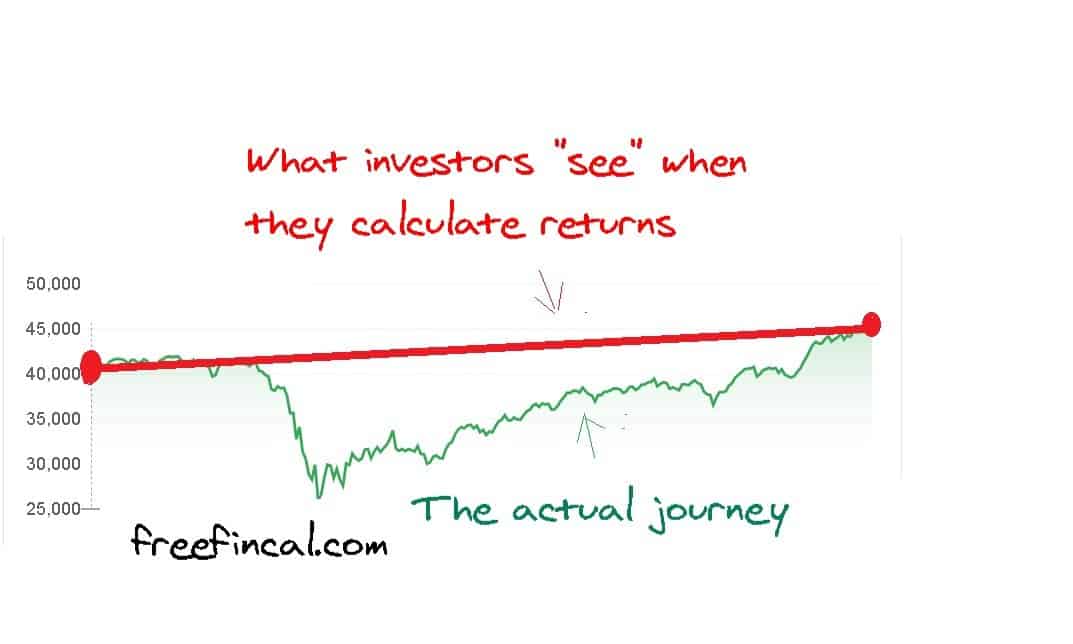
Forget practicality; even technically, the SIP vs lump sum comparison is on shaky ground because, in SIP, each instalment is done at different market levels. The XIRR is a CAGR “average”. So it is an apple vs orange comparison, however way we look at it.
When people ask, “lump sum or SIP, which is better?” what they really mean is, “I have some cash that I wish to invest; should I invest it in one shot or should I inevst little by little (STP) each?”. The answer to that is, “over the long-term, it does not matter!”. See: Investing a lump sum in one-shot vs gradually (STP) in an equity mutual fund (backtest results) Sometimes STP does better and sometimes lump sum. You cannot know how your investment choice will work in future!
This distinction is important because if you wish to compare 10-year lump sum returns with 10-year SIP returns, it can be done, but it is of little use. If you have a lump sum and wish to enter the market “gradually”, you will do it over the next 12-24 months and not over the next 120 months!!
For what it is worth, here is a comparison of 10-year lump sum returns vs 10-year SIP (XIRR) returns (y-axis) of 241 equity mutual funds.
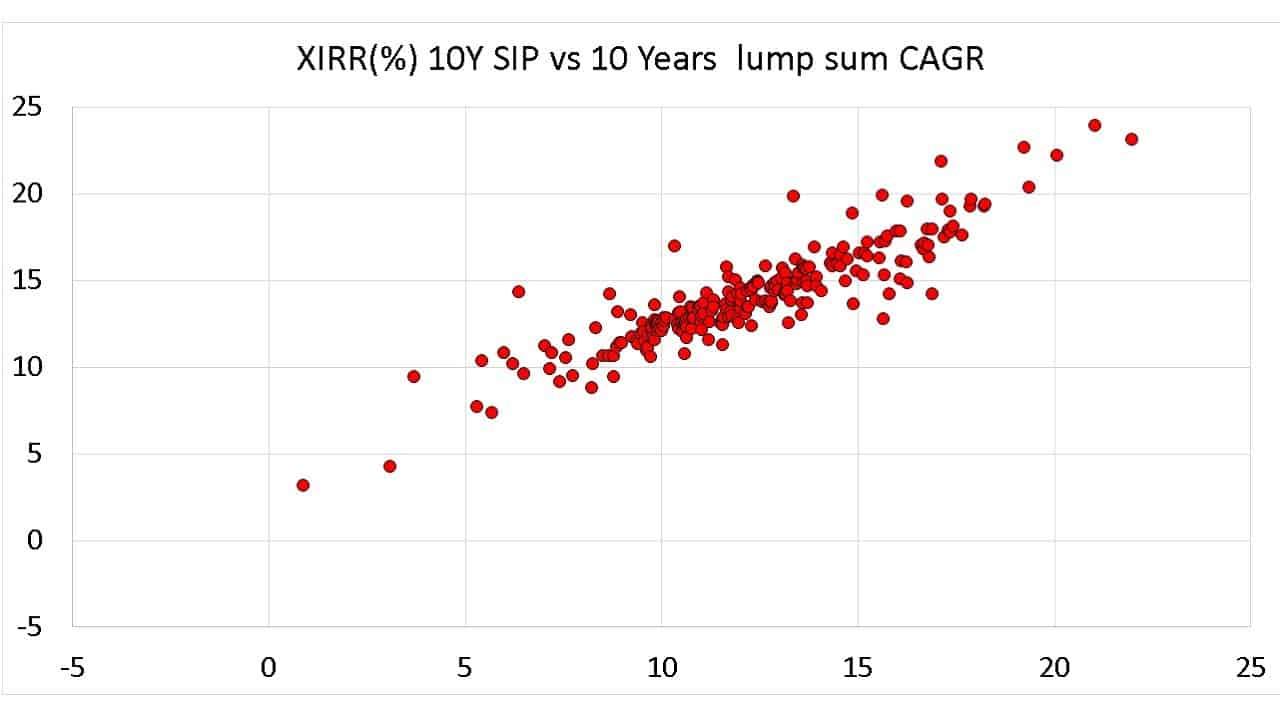
This is the 5-year lump vs 5-year SIP returns of 308 equity funds.
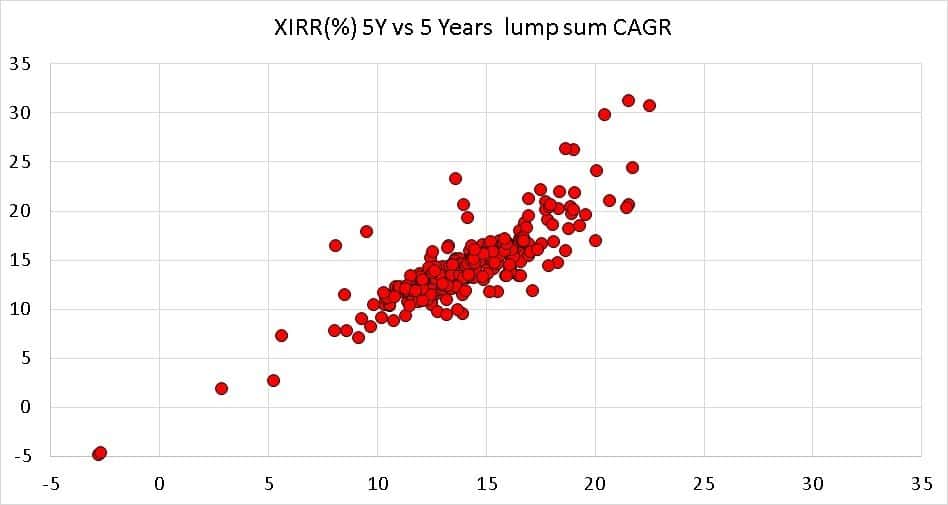
The x- and y-axis have the same graduations for easier comparison, and you can notice two aspects. (1) A higher lump sum returns typically mean higher SIP returns. The reason for this is, after a few instalments, a SIP is essentially equivalent to a SIP as shown before: SIP vs Lump Sum Investment: Which reacts to market changes more?
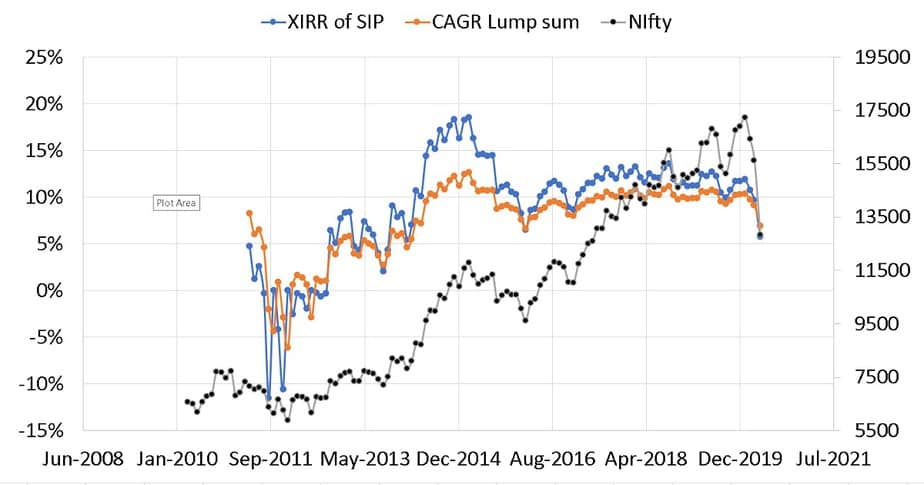
These are the progressive XIRR/CAGR values after each month of investment. Amusingly it is the SIP that reacts more to both up and down market movements than the lump sum! On the day of SIP or lump sum return calculation, if the market is “up”, returns are “up”, if the market is “down”, returns are “down”. A SIP does not reduce risk in any way.
(2) While comparing the 5Y and 10Y lump sum vs SIP returns, you may notice that SIP returns are a “bit higher”. This is not some big finding. Aside from the impracticality of the comparison, we are only looking at one trailing return window. If you looked at 10-year rolling lump sum vs 10-year rolling SIP returns of the Nifty 50 TRI, would you say lump sum is better? Even if you think that, how will you get the money you will invest over the next 10 years to invest in one shot today?
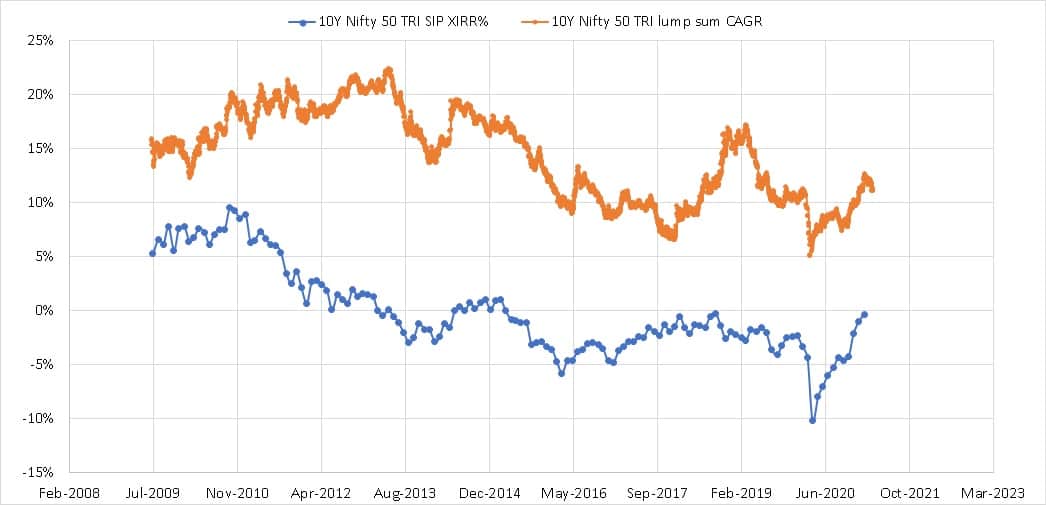
In summary, lump sum vs SIP comparison is meaningless. If you have a lump sum, there is no way to know beforehand which will fetch you better returns – investing in one shot or gradually over a few months (manually or automated via STP). So all you can do is use common sense. Investing in a lump sum gradually over a few months (don’t break your head over how many months!!) will minimise regret.
🔥Enjoy massive discounts on our courses, robo-advisory tool and exclusive investor circle! 🔥& join our community of 7000+ users!
Use our Robo-advisory Tool for a start-to-finish financial plan! ⇐ More than 2,500 investors and advisors use this!
Track your mutual funds and stock investments with this Google Sheet!
We also publish monthly equity mutual funds, debt and hybrid mutual funds, index funds and ETF screeners and momentum, low-volatility stock screeners.





- Do you have a comment about the above article? Reach out to us on Twitter: @freefincal or @pattufreefincal
- Have a question? Subscribe to our newsletter using the form below.
- Hit 'reply' to any email from us! We do not offer personalized investment advice. We can write a detailed article without mentioning your name if you have a generic question.
Join 32,000+ readers and get free money management solutions delivered to your inbox! Subscribe to get posts via email! (Link takes you to our email sign-up form)
About The Author
 Dr M. Pattabiraman(PhD) is the founder, managing editor and primary author of freefincal. He is an associate professor at the Indian Institute of Technology, Madras. He has over ten years of experience publishing news analysis, research and financial product development. Connect with him via Twitter(X), Linkedin, or YouTube. Pattabiraman has co-authored three print books: (1) You can be rich too with goal-based investing (CNBC TV18) for DIY investors. (2) Gamechanger for young earners. (3) Chinchu Gets a Superpower! for kids. He has also written seven other free e-books on various money management topics. He is a patron and co-founder of “Fee-only India,” an organisation promoting unbiased, commission-free investment advice.
Dr M. Pattabiraman(PhD) is the founder, managing editor and primary author of freefincal. He is an associate professor at the Indian Institute of Technology, Madras. He has over ten years of experience publishing news analysis, research and financial product development. Connect with him via Twitter(X), Linkedin, or YouTube. Pattabiraman has co-authored three print books: (1) You can be rich too with goal-based investing (CNBC TV18) for DIY investors. (2) Gamechanger for young earners. (3) Chinchu Gets a Superpower! for kids. He has also written seven other free e-books on various money management topics. He is a patron and co-founder of “Fee-only India,” an organisation promoting unbiased, commission-free investment advice.Our flagship course! Learn to manage your portfolio like a pro to achieve your goals regardless of market conditions! ⇐ More than 3,000 investors and advisors are part of our exclusive community! Get clarity on how to plan for your goals and achieve the necessary corpus no matter the market condition is!! Watch the first lecture for free! One-time payment! No recurring fees! Life-long access to videos! Reduce fear, uncertainty and doubt while investing! Learn how to plan for your goals before and after retirement with confidence.
Our new course! Increase your income by getting people to pay for your skills! ⇐ More than 700 salaried employees, entrepreneurs and financial advisors are part of our exclusive community! Learn how to get people to pay for your skills! Whether you are a professional or small business owner who wants more clients via online visibility or a salaried person wanting a side income or passive income, we will show you how to achieve this by showcasing your skills and building a community that trusts and pays you! (watch 1st lecture for free). One-time payment! No recurring fees! Life-long access to videos!
Our new book for kids: “Chinchu Gets a Superpower!” is now available!


Must-read book even for adults! This is something that every parent should teach their kids right from their young age. The importance of money management and decision making based on their wants and needs. Very nicely written in simple terms. - Arun.Buy the book: Chinchu gets a superpower for your child!
How to profit from content writing: Our new ebook is for those interested in getting side income via content writing. It is available at a 50% discount for Rs. 500 only!
Do you want to check if the market is overvalued or undervalued? Use our market valuation tool (it will work with any index!), or get the Tactical Buy/Sell timing tool!
We publish monthly mutual fund screeners and momentum, low-volatility stock screeners.
About freefincal & its content policy. Freefincal is a News Media Organization dedicated to providing original analysis, reports, reviews and insights on mutual funds, stocks, investing, retirement and personal finance developments. We do so without conflict of interest and bias. Follow us on Google News. Freefincal serves more than three million readers a year (5 million page views) with articles based only on factual information and detailed analysis by its authors. All statements made will be verified with credible and knowledgeable sources before publication. Freefincal does not publish paid articles, promotions, PR, satire or opinions without data. All opinions will be inferences backed by verifiable, reproducible evidence/data. Contact information: To get in touch, use this contact form. (Sponsored posts or paid collaborations will not be entertained.)
Connect with us on social media
- Twitter @freefincal
- Subscribe to our YouTube Videos
- Posts feed via Feedburner.
Our publications
You Can Be Rich Too with Goal-Based Investing
 Published by CNBC TV18, this book is meant to help you ask the right questions and seek the correct answers, and since it comes with nine online calculators, you can also create custom solutions for your lifestyle! Get it now.
Published by CNBC TV18, this book is meant to help you ask the right questions and seek the correct answers, and since it comes with nine online calculators, you can also create custom solutions for your lifestyle! Get it now.Gamechanger: Forget Startups, Join Corporate & Still Live the Rich Life You Want
 This book is meant for young earners to get their basics right from day one! It will also help you travel to exotic places at a low cost! Get it or gift it to a young earner.
This book is meant for young earners to get their basics right from day one! It will also help you travel to exotic places at a low cost! Get it or gift it to a young earner.Your Ultimate Guide to Travel
 This is an in-depth dive into vacation planning, finding cheap flights, budget accommodation, what to do when travelling, and how travelling slowly is better financially and psychologically, with links to the web pages and hand-holding at every step. Get the pdf for Rs 300 (instant download)
This is an in-depth dive into vacation planning, finding cheap flights, budget accommodation, what to do when travelling, and how travelling slowly is better financially and psychologically, with links to the web pages and hand-holding at every step. Get the pdf for Rs 300 (instant download)